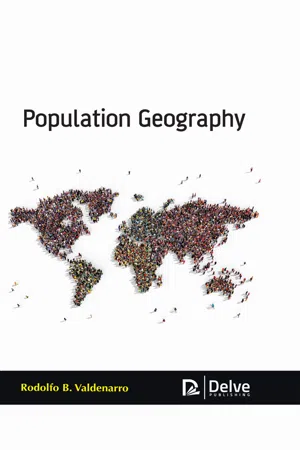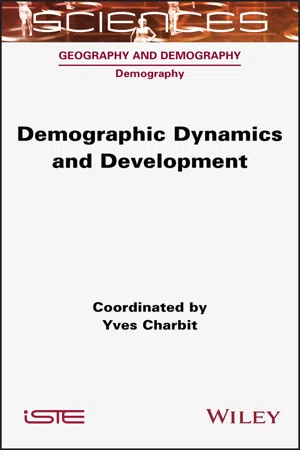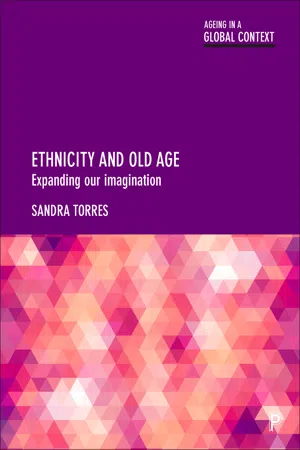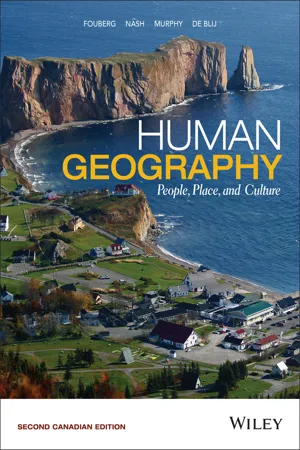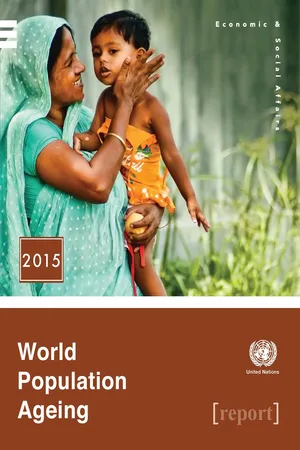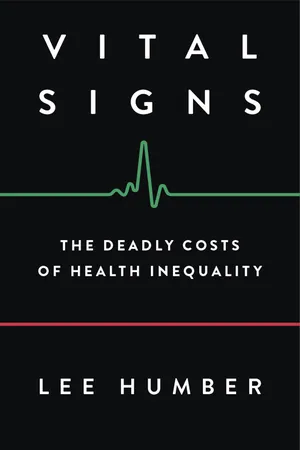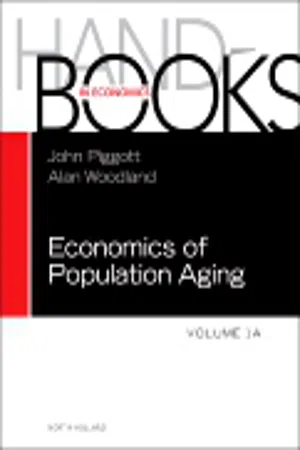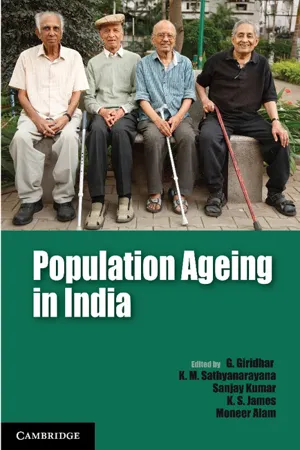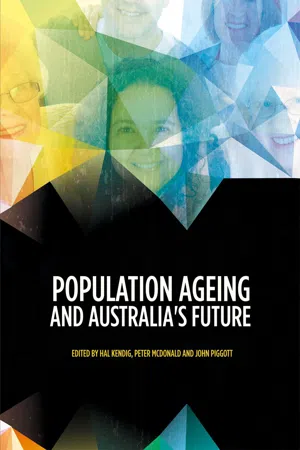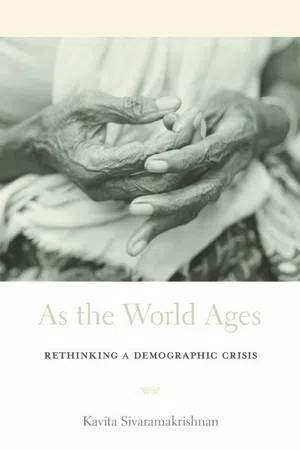Geography
Aging Populations
Aging populations refer to a demographic trend characterized by a growing proportion of elderly individuals within a population. This phenomenon is often attributed to declining birth rates and increased life expectancy. It has significant implications for healthcare, social welfare, and economic systems, as it can lead to a greater demand for elderly care and pension provisions, as well as potential labor force shortages.
Written by Perlego with AI-assistance
Related key terms
1 of 5
10 Key excerpts on "Aging Populations"
- eBook - PDF
- Rodolfo B. Valdenarro(Author)
- 2020(Publication Date)
- Delve Publishing(Publisher)
It can be expounded as a general term for the conveyance in a population’s age composition to older ages as a result of demographic transition. Population aging can also be termed as demographic aging and warrants the surge in the older ages’ percentage composition of the overall population. Older ages are assumed as 65 years of age and above. Among the key facets of population aging are (Figure 3.1): • A population’s median or mean age increase; • An increase in the elderly population composition; • A decrease in the population whose age group is less than 15 years of age. Figure 3.1. Population aging. Source: https://www.npr.org/sections/health-shots/2013/10/08/230175345/de-laying-aging-may-have-a-bigger-payoff-than-fighting-diseases. Population Aging 73 3.2.1. What Exactly Is Demographic Transition? Demographic transition is simply a process involving the methodical shift of demographic changeable from an initial state to a distinct one. It can also be termed as the progressive adaptation from high rates of births and deaths to significantly low death and birth rates accompanying both economic and social changes facilitated by industrial modernization. Demographic transition has been established as the reason behind population aging in both developed and developing countries, with a gradual and rapid transition, respectively. Throughout the demographic transition, the decline in fertilities happens to be the key contributor to population aging as it proliferates the older ages population percentage. Also, the demographic aging process is further accelerated by mortality dwindling in old ages which significantly spirals the population of the aged. In Africa for example, aging of the population has been effectuated by a rapid decrease in fertility rates as a result of various socio-economic progressions and developments including the surging adoption and employment of contraceptives. - eBook - PDF
- Yves Charbit(Author)
- 2022(Publication Date)
- Wiley-ISTE(Publisher)
9.2. The aging of the world population: a demographic revolution Following the decline in fertility and mortality (section 9.2.2), the aging of the world population is a fundamental transformation in global demographic dynamics (section 9.2.1). Its consequences reverberate in many areas of society (section 9.2.3). The statistical data used here have been drawn from the United Nations, both to assess the current state-of-the-art and establish demographic projections. 9.2.1. The demographic dynamics of aging Loriaux (2002) wrote: One thing is certain: aging is a process, and like many others, is undergoing the process of globalization. It should be considered as a heavy, unavoidable and irreversible current, to which reason has to adapt as best as possible, rather than trying to stop it in vain (Loriaux 2002, p. 25). Aging 203 Ten years later, after interviewing a panel of 970 demographers around the world, Van Dalen and Henkens (2012) concluded that for this scientific community, demographic aging is a major topic for the future. Finally, for Zimmer and McDaniel (2016), “it is not hyperbole to say that the aging of the global population will be among the most important phenomena driving policy around the world over the next number of decades” (p. 1). These references indicate that demographic aging must be considered as a global scope phenomenon, in that it concerns all countries and also has repercussions on the entire planet. In this regard, it seems reasonable to consider its importance at the same level as that of climate change, whose evolution has also been observed over several decades. However, despite its unprecedented, universal and irreversible character, global aging is far from having a media impact as strong as that of global warming. Beyond the statistical data proposed in the introduction, world population aging began around the 1960s and has accelerated since the 2010s (Figure 9.1). - eBook - PDF
Ethnicity and Old Age
Expanding our Imagination
- Torres, Sandra(Authors)
- 2019(Publication Date)
- Policy Press(Publisher)
The remaining countries belong to the LDC category. 2 For insights into the variations in the sources of population ageing, see Davies and James (2011). For insights into the drivers of population ageing in Central 26 Ethnicity and old age often refer to fertility and mortality data as well as increased longevity when describing the reason why different countries are ‘greying’. Irrespective of what is driving the ageing of the world’s population forward, population ageing is a demographic transition that worries demographers and policy makers alike, since the rapid ageing of populations means that new challenges related to health, labour supply and economic growth will arise. Concerning health challenges, it has been noted, for example, that ‘nearly one quarter of the world’s burden of disease is attributable to illnesses in adults aged sixty and over’ (Bloom et al., 2015: 82–4). This is why countries around the world (and especially those with highly developed welfare systems) are worried about the growing disease burden that they expect population ageing to bring. The challenge is not only being able to provide the care that growing numbers of older people are believed to need but also that countries’ economic growth is expected to slow down because the kinds of diseases that older people tend to suffer from (such as heart disease, cancer, musculoskeletal conditions and mental disorders such as Alzheimer’s disease and other dementias) are not only expensive to treat but also require new ways of designing health care in old age (Prince et al., 2014). The fact that these diseases can diminish our capacity to participate in the labour market is also a source of concern for policy makers since one of the economic challenges that population ageing is believed to bring is a shortage of labour. In regard to this, Bloom and colleagues (2015: 84) argue that in many countries, labour force participation falls off drastically at older ages. - eBook - PDF
Human Geography
People, Place, and Culture
- Erin H. Fouberg, Alexander B. Nash, Alexander B. Murphy, Harm J. de Blij(Authors)
- 2015(Publication Date)
- Wiley(Publisher)
When they have grasped the characteristics of populations Population geography The study of why populations have certain characteristics and why they distribute themselves across space in particular ways. Demography The study of the characteristics of a population, such as race, age, sex, and ethnicity. 92 CHAPTER 4 Population and their locations, other questions arise: Why are some popu- lations aging more quickly than others? Why might there be significantly more men than women in countries such as China or India? Why do particular ethnic groups seem to favour living and working in certain locales? Why do certain population groups, such as Millennials, prefer urban (or suburban or rural) settings? Population geographers are also concerned with more abstract questions about populations, such as how the term “population” comes to be understood as an object or a “thing,” who becomes part of a “population,” and how these “popula- tions” are regulated and controlled through state policy and governance. Before we can begin to work through some of these more detailed questions, we need to compile and understand a few basic facts about the populations we are interested in studying. Population geographers undertake basic calculations about a particular population, such as its density, distribution, and composition. This information provides the starting point for considering the complex spatial organization and movement of populations. POPULATION DENSITY Demographers report the population density of a country as a measure of total population in relation to total land area. They usually calcu- late density as the number of people located in a particular territorial unit—usually a square kilometre. This is a rather simplistic calculation, as it assumes an even distribu- tion of the population over the total land or territory in ques- tion. - No longer available |Learn more
- United Nations Department of Economic and Social Affairs(Author)
- 2017(Publication Date)
- United Nations Publications(Publisher)
United Nations Department of Economic and Social Affairs ǀ Population Division 41 III. Demographic drivers of population ageing The size and age composition of a population are determined jointly by three demographic processes: fertility, mortality and migration. Fertility levels and trends determine the size of each birth cohort; while mortality levels and trends determine what proportion of those cohorts eventually survive to old age. Age patterns of immigration and emigration also influence the age distribution of the population, although to a lesser extent than fertility and mortality in most countries. This chapter describes the relationships between the three main demographic processes and population ageing, drawing primarily upon United Nations population estimates and projections from World Population Prospects: the 2015 Revision . A. F ERTILITY AND MORTALITY AS DETERMINANTS OF TRENDS IN THE NUMBERS OF OLDER PERSONS The present growth rate of the population of older persons is a function of the levels of fertility prevailing some 60 years ago when today’s new cohorts of older persons were born, together with the likelihood that members of those birth cohorts survived to older ages. Figure III.1 shows the growth rate of the population aged 60 or over in 2010-2015 versus the total fertility rate (expressed as the average number of children per woman) 60 years earlier, in 1950-1955, for countries or areas with at least 500,000 residents aged 60 years or older in 2015. 12 In general, countries that had high fertility 60 years ago saw faster growth in the number of older persons during 2010-2015. In the Philippines, for example, the total fertility rate was 7.4 children per woman in 1950-1955, and today, the number of older people (aged 60 years or over) is growing rapidly, at an average 3.6 per cent per year in 2010-2015. - eBook - PDF
Vital Signs
The Deadly Costs of Health Inequality
- Lee Humber(Author)
- 2019(Publication Date)
- Pluto Press(Publisher)
63 6 Ageing Populations? The concept of an ageing population, with its implicit reference to the idea that people are living longer, has particular relevance for a book on health and health inequality, since the average number of years that a person lives is one relatively crude measure of how healthy that population is. In a very real sense, it should be an occasion for cele-bration of a society’s success. However, ageing population concepts are not usually thought of in this positive light. Most often, in science and popular discourse, the phrase conjures up images of global economies being burdened with an ever-increasing number of older people, living longer than ever and using up increasingly scarce healthcare resources while draining tax revenues by drawing on national pension pots for longer. Ageing population arguments have been called the ‘voodoo demography’ by their critics, a term first coined in 2000 in response to the growing clamour around the social costs associated with rising life expectancies. 1 So, while it is the case that the average ages of populations globally have increased over the last 20 years, including recently for those in many LMICs, there is an ideological element to the concept that needs to be understood. This chapter seeks to do that, in the process explaining how these averages are calculated, exploring the broader social factors underpinning the rise and arguing that people living longer is far from being a social negative. Average life expectancies in the UK have increased consistently since the end of World War II. The number of people in their 70s in the UK increased from four million to five million between 1990 and 2016. Survival rates were far better for the post-World War II baby boom generation (born 1946 and onwards) than those born following the World War I baby boom (born 1920). - John Piggott, Alan Woodland(Authors)
- 2016(Publication Date)
- North Holland(Publisher)
Migration, Aging, and Health 161 6. Conclusions 167 Acknowledgments 169 References 169 Abstract This chapter investigates the two-way relationship between population aging and international migra-tion. After documenting the trends for both, we review the supply-push and demand-pull deter-minants of migration, focusing particularly on the role of age and aging. We subsequently analyze the implications of migration in the context of aging for labor markets, as well as for health and public budgets, including in the context of political economy. Although immigration is sometimes suggested as a solution for the aging problem, the existing academic literature from different fields is more cautious about its role and potential. While some suggest that large-scale, selective immigration might contribute to alleviating demographic pressures, in general, researchers conclude that migration alone is not likely to play a significant role. Keywords Aging, Migration, Demographic pressures, Elderly migration, Attitudes toward migration, Political economy of immigration 119 Handbook of the Economics of Population Aging , Volume 1A © 2016 Elsevier B.V. ISSN 2212-0076, http://dx.doi.org/10.1016/bs.hespa.2016.08.002 All rights reserved. JEL Classification Codes F22, F66, J11, J14, J61, O15 1. INTRODUCTION The demographic shift to low mortality and low fertility, as well as its implied population aging and shrinking working-age population, is one of the most important challenges for many countries to achieve a prosperous future. The expected changes threaten the func-tionality of labor markets, the sustainability of pension and healthcare systems, and public budgets. Therefore, methods and policies for alleviating aging challenges have been gaining greater importance for researchers and policymakers.- eBook - PDF
- G. Giridhar, K. M. Sathyanarayana, Sanjay Kumar, K. S. James, Moneer Alam(Authors)
- 2014(Publication Date)
- Cambridge University Press(Publisher)
Demographics of Population Ageing in India Lekha Subaiya Dhananjay W. Bansod CHAPTER 1 Introduction A major emerging demographic issue of the twenty-first century is the ageing of populations as an inevitable consequence of the demographic transition experienced by most countries. Across the world, declining fertility and increased longevity have resulted in higher numbers and proportions of older persons 60 years and above. This trend is expected to continue as the estimated 737 million older persons in 2009 (United Nations, 2009) were projected to increase to 2 billion by 2050 at which time the proportion of the population age 60+ years will outnumber the proportion of the population who are children (of 0–14 years age). The oldest-old age segment (80 years and above) is the fastest growing segment and by 2050 about 20 per cent of older persons will be 80 years and above. The coming decades therefore will be characterized by the ageing of the aged. Of particular relevance is the fact that in 2009 two-thirds of the world’s older persons lived in developing countries (55 per cent in Asia alone), regions that are much less prepared to deal with this aspect of population dynamics compared to more developed countries. The ageing of populations has significant implications for older persons themselves, as well as the families and societies they live in. This recognition resulted in the World Assembly on Ageing being held in 2002 with 159 countries adopting the Madrid Plan of Action on Ageing (MPAA) which focuses on how the needs of older persons can be mainstreamed into development. 2 Lekha Subaiya For many years population ageing was considered to be a phenomenon of importance only to the more developed countries of Europe and North America and to Japan in Asia. At 21 per cent of the total population in 2009, the proportion of older persons 60 years and above is much higher in the more developed regions compared to the 8 per cent in the developing regions. - eBook - PDF
- Hal Kendig, Peter Mcdonald, John Piggott(Authors)
- 2016(Publication Date)
- ANU Press(Publisher)
POPULATION AGEING AND AUSTRALIA'S FUTURE 112 ‘Ageing society’ refers to a specific type of society that emerges during demographic transition in which large shares of populations become old (65+) and very old (80+). Ageing societies share a number of similar challenges, such as widening individual ‘problems of ageing’ (poor health, loneliness, social isolation, impoverishment of old people); depletion of the labour force and an increasing dependency ratio, which together slow down growth; rising pension, aged-care and health costs and accompanying budgetary strains; and the increasing generational pressures of ‘silver/grey lobbies’ that contribute to rising conservatism, slow down reforms and threaten to skew the allocation of resources (e.g. United Nations 2001; Harper 2006; Harper and Hamblin 2014). It is estimated that the proportion of such older (60+) people worldwide—at present around 12 per cent—will nearly double by 2050. Even in Australia, where the total fertility rate is relatively high (1.9), and where immigration of young people also remains high, thus ‘cushioning’ the impact of ageing, the proportion of people aged over 65 will double by mid-century from about 13 per cent to about 27 per cent, with centenarians constituting 0.01 per cent of the total population. 1 In Poland, where the process of ageing has been aggravated by a low (1.3) fertility rate and high emigration of young people, the anticipated change is more rapid and—potentially—more disruptive, with the population shrinking, an estimated 30 per cent of people reaching the retirement age by 2050, and the age dependency ratio more than doubling. As would be expected, with the process of ageing accelerating in most developed societies, the attention paid to population ageing and the challenges that accompany it has been increasing. - eBook - PDF
As the World Ages
Rethinking a Demographic Crisis
- Kavita Sivaramakrishnan(Author)
- 2018(Publication Date)
- Harvard University Press(Publisher)
131 5 The Birth of Global Aging and Its Local Afterlives I n July 1982, the UN hosted a World Assembly on Aging (WAA) in Vi-enna and anointed population aging as a global problem. Population aging had been of immediate concern only to developed countries, but now the issue was an agenda that linked the developed and developing worlds and was projected as representing a shared future. 1 At the WAA and in its echoes in subsequent years, policymakers from developing countries and international and national experts would unanimously declare that popu-lation aging was now a “universal phenomenon.” Between the 1950s and 1970s, “old age” as a distinct social stage with particular roles and needs had become a category of analysis and the subject of a new field of inter-national research and practice. It had increasingly caught the attention of social workers in newly founded social work schools and departments and among sociologists studying urban social change in families and commu-nities. 2 Although aging’s reach as a wider welfare concern spanned many developing countries, neither studies on aging and social adjustment nor meetings held by networks of international gerontologists alone could have created the momentum for a transnational worldview of aging. 132 AS THE WORLD AGES In the arena of population and development between the 1950s and the 1970s, experts referred to future and probable demographic shifts in devel-oping countries, but no significant interest was expressed in this subject. In August 1974, at the United Nations World Population Conference held in Bucharest, the who’s who of population control, including heads of government, met to review a decade of contentious population control programs and goals.
Index pages curate the most relevant extracts from our library of academic textbooks. They’ve been created using an in-house natural language model (NLM), each adding context and meaning to key research topics.
